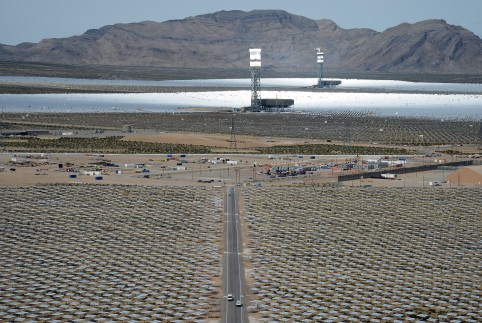World’s Largest Solar Generating Plant Struggles to Make Ends Meet if the Sun Doesn’t Shine
Who knew? In the midst of free-falling oil prices that have knocked about the growth plans for petroleum developers, owners of the world’s largest solar power plant have discovered that cloudy days significantly reduce their revenues.
“Industry-wide figures suggest that a 5% negative anomaly in solar irradiation during the summer months for a CSP [concentrating solar power/thermal solar] or PV [photovoltaic solar] site can translate to a 1% to 1.5% decrease in annual revenue for a solar developer or operator, highlighting a clear industry requirement to take a more comprehensive approach to gathering long-term weather data,” according to Vaisala, an industrial and environment measurement consultancy based in Finland. The quote is from Vaisala’s analysis of 2014 solar irradiance.
The particular solar plant suffering from reduced irradiance is the Ivanpah Solar Electric Generating System sitting on 3,500 acres in California’s Mojave Desert southwest of Las Vegas. Ivanpah is a thermal solar power plant with a gross capacity of 392 megawatts. The plant is owned and operated by NRG Energy (ticker: NRG), Google (ticker: GOOG) and developer BrightSource (pending ticker: BRSE). Other partners include privately owned Bechtel Corp. and the Department of Energy.
Concept Smacks of ‘Wow’, Operational and Fiscal Reality Not So Much
 The theory and design of the plant is nothing short of amazing. It is something that makers of futuristic Hollywood movies would devour.
The theory and design of the plant is nothing short of amazing. It is something that makers of futuristic Hollywood movies would devour.
Install 347,000 mirrors on the desert floor near Needles, California. Point all the mirrors with their reflected thermal radiation toward the glowing concentrators placed atop three 450-foot tall towers. Direct the intense heat from each tower into a boiler that generates steam that turns a turbine which generates electricity. The electricity from Ivanpah’s thermal solar system generates no carbon dioxide, but neither does it generate electricity when clouds, dust or nightfall interrupt the plant’s supply of fuel—solar irradiance.
According to multiple sources, the plant thus far has generated “hundreds of thousands of dollars less than expected. … If the weather isn’t cooperating, developers can take a big financial hit,” the Energy Collective reported this week.
Revenue Shortfall Tumbles onto U.S. Taxpayers, Creates Need to Use More Reliable Fuel: NatGas
According to the Energy Collective report, “project owners are now taking advantage of cash grants from the Treasury to help repay their initial loan from the Department of Energy. They’re also burning more natural gas to make up for the drop in electricity output.”
After the plant came online, operators realized that the plant would need to rely on natural gas-fired auxiliary boilers to “prime the system in the early morning, allowing the plant to begin generating electricity as soon as possible after sunrise; to maintain performance during intermittent cloud cover; and to eke out more energy as the sun fades at the end of the day,” according to a report by Breaking Energy.
Plant construction began in 2010 using a $1.6 billion federal loan guarantee. Ivanpah began commercial operations in Dec. 2013, and “for the eight-month period from January through August [2014], its three units generated 254,263 megawatt-hours of electricity, according to U.S. Energy Information Administration data,” which is about one fourth of expectations, the Breaking Energy report said.
“The road ahead is clear, the costs of renewable energy has nowhere to go but down, whereas the cost of fossil fueled generation will only rise as critical natural resources diminish,” according to Vaisala in its Vaisala News Energy Issue 2014. The statement was obviously written prior to September of 2014.
“You can be really surprised when there’s a bad year and not understand what’s going on,” a Vaisala spokesperson commented in regard to financial problems caused by reduced irradiance at solar power plants.
Important disclosures: The information provided herein is believed to be reliable; however, EnerCom, Inc. makes no representation or warranty as to its completeness or accuracy. EnerCom’s conclusions are based upon information gathered from sources deemed to be reliable. This note is not intended as an offer or solicitation for the purchase or sale of any security or financial instrument of any company mentioned in this note. This note was prepared for general circulation and does not provide investment recommendations specific to individual investors. All readers of the note must make their own investment decisions based upon their specific investment objectives and financial situation utilizing their own financial advisors as they deem necessary. Investors should consider a company’s entire financial and operational structure in making any investment decisions. Past performance of any company discussed in this note should not be taken as an indication or guarantee of future results. EnerCom is a multi-disciplined management consulting services firm that regularly intends to seek business, or currently may be undertaking business, with companies covered on Oil & Gas 360®, and thereby seeks to receive compensation from these companies for its services. In addition, EnerCom, or its principals or employees, may have an economic interest in any of these companies. As a result, readers of EnerCom’s Oil & Gas 360® should be aware that the firm may have a conflict of interest that could affect the objectivity of this note. The company or companies covered in this note did not review the note prior to publication. EnerCom, or its principals or employees, may have an economic interest in any of the companies covered in this report or on Oil & Gas 360®. As a result, readers of EnerCom’s reports or Oil & Gas 360® should be aware that the firm may have a conflict of interest that could affect the objectivity of this report.

